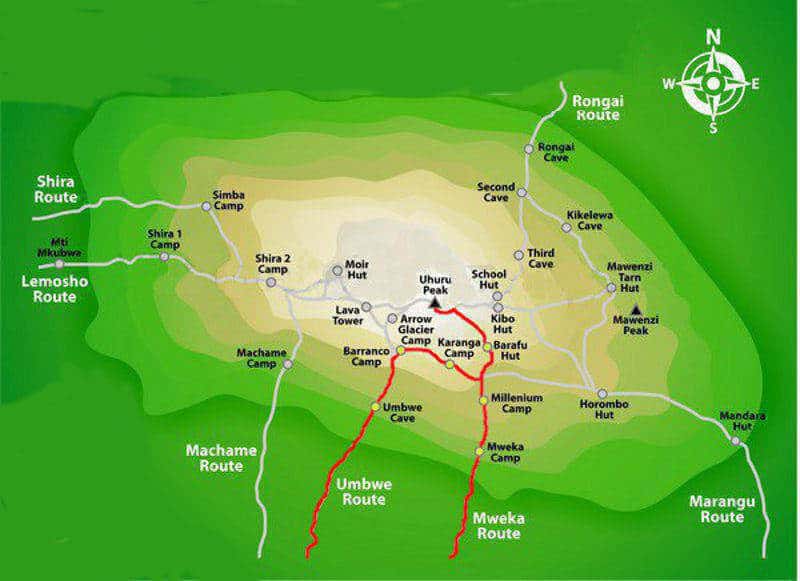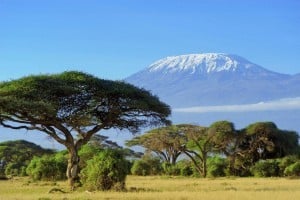Mweka route:
Day one:
To / from: Umbwe Gate (2100 meters) – Umbwe Cave (2940 m).
Duration climb: 5 to 6 hours.
Setting: Tropical rainforest.
Depending on your arrival, we leave early in the morning to Moshi to the entrance of the Umbwe Park, the ride takes you through several villages with great coffee and banana plantations. When Umbwe Gate draw the registry, and climb to the first camp. The tour takes you through the tropical rainforest at the foot of Mount Kilimanjaro, there can be seen a multitude of tropical birds, monkeys and other animals. Walk under more Lonzo along the river and the Umbwe river at the foot of these rivers are huge trees, the path is easy to follow, and the first climb is relatively easy.
LB, AM.
Day two:
To / from: Umbwe Cave (2940 meters) – Barranco Camp (4000 meters).
Duration climb: 6 to 7 hours.
Setting: Tropical rainforest and Moorland (lunar).
Shortly after leaving the camp, the woods are covered less dense, and moss grows on the trunks, the area is about following a more rocky area. The trail gets very steep, and you walk across a narrow path to the top. The view of Kilimanjaro here is very spectacular. If you Barranco Valley nearing the path becomes more passable, save your camp in the Valley at the foot of the Barranco Wall. By the nightfall you will see a very spectacular sunset here. If you have inserted an extra acclimatization (which is recommended), then you stay here a day longer.
O, LB, AM.
Day three:
From / to Barranco Camp (4000 meters) – Lava Tower (4600 meter).
Duration climbing: 5 hours.
Surroundings: Moorland and desert.
After breakfast you walk towards the Lava Tower, a known point on Mount Kilimanjaro. The trail is steep and there are many rocks, you have a good view of Mount Meru, which are top pierces through the clouds.
O, LB, AM.
Day four:
From / to Lava Tower (4600 meters) – Arrow Glacier Camp (4800 meters).
Duration: 3 to 4 hours.
Surroundings: Rock / stone, snow / ice fields.
After breakfast, take the path for the Western Breach, a steep climb to the Arrow Glacier Camp. The first symptoms of altitude sickness are palpable, the camp is spectacular, with huge rock walls.
O, LB, AM.
Day five:
From / to Arrow Glacier Camp (4800 meters) – Uhuru Peak (5895 m, top) – Mweka Camp (2800 meters).
Duration: Arrow Glacier – Uhuru Peak 6 to 7 hours, Uhuru Peak – Mweka Camp 5 to 6 hours.
Environment: snow / ice fields, moorland.
You leave in the middle of the night, about twelve o’clock, first climbs Gilmans Point to see an unforgettable sunrise here, then climb to Uhuru Peak (top), and then you drop back to Mweka Hut, where you will no doubt exhausted, but satisfied to enjoy your sleep. This is by far the hardest part of the climb.
O, LB, AM.
Day six:
From / to Arrow Glacier Camp (4800 meters) – Uhuru Peak (5895 m, top) – Mweka Camp (2800 meters).
Duration: 3 to 4 hours.
Setting: Tropical rainforest.
After a hearty breakfast, walk to the Mweka Gate, where you write your name and other details in a register, hereafter you will be brought in Moshi or Arusha to your hotel.
Oh, LB.
Included:
National Park fees, camping fees, rescue fees.
Full board camping accommodation during ascent.
English speaking guide, cook and porters.
Camping materials.
Getting to Mount Kilimanjaro, and back to Arusha.
Three meals a day
Sleeping bag and mattress
Not included:
Meals and accommodation in Arusha
Personal expenses and gratuities.
Toiletries
Tips
Prices:
Six days, five nights
2 persons: 1395€ per person
3+ persons: 1345€ per person
If you have taken Gilmans Point or Uhuru Peak, you get at the entrance / exit a certificate with the message that you have reached the highest point in Africa
.
Beware!
Climbing Mt. Kilimanjaro is often taken lightly, because we no ropes, irons or other attachments need, this does not mean that you will reach the top. Every year approximately 22 000 people start the climb to the summit of Mount Kilimanjaro only 60% gets the actual summit also (Uhuru Peak). 40% do not make it have different reasons, it may be because their condition is not good enough, or that they deal with altitude sickness get (throbbing headache, vomiting, nausea, and feeling tired and lethargic), in most cases, this time will be noticed by your guide, but unfortunately there are still too many incompetent guides, or not notice this too late.
Every year people die by incompetent guides, be sure you book with a professional and competent company.
I climbed myself Kilimanjaro, it is a fantastic ascent you the rest of your life with will continue, but beginning well organized the climb, these are a few tips that I would definitely recommend also these tips to increase your chances on reaching the summit considerably:
Train at least two months before your departure two to three times a week, you can go jogging or take long walks.
Train with a backpack of at least five kilos you carry on Mt. Kili itself a backpack that weighs about five kilograms (packed lunch, camera, binoculars, water, etc.), if you’ve never trained with this you get great muscle soreness in your shoulders.
Walk in your shoes, so do not go with brand new shoes on the mountain.
Get enough socks dry, this helps prevent blisters.
Take a high factor sunscreen, factor 25 or 30, at 3000-4000 meters altitude you naturally burn faster.
Take muesli bars and glucose along (dextro energy).
Enough warm clothes (flees).
Sufficient water purification tablets.
Norit tablets.
Good sunglasses (with UV filter).
Any tablets that help prevent altitude sickness, such as Diamox.
Headlamp or flashlight.
Rainwear.
Reading book and / or music.
Drink plenty of water during each trip.
Walk slowly and enjoy the surroundings. (too quickly climb up increases the risk of altitude sickness).




